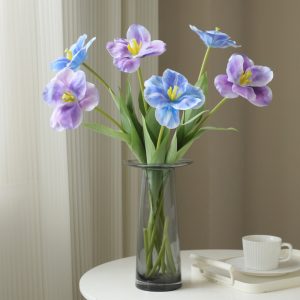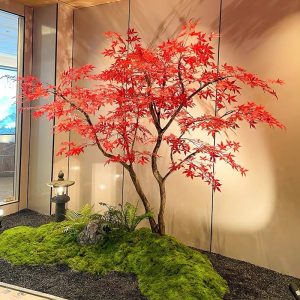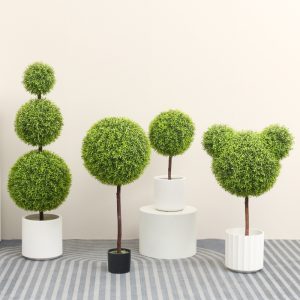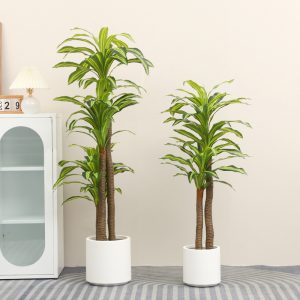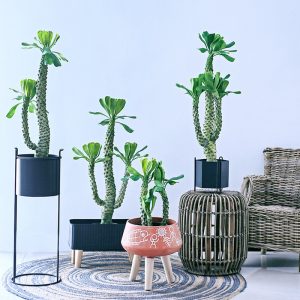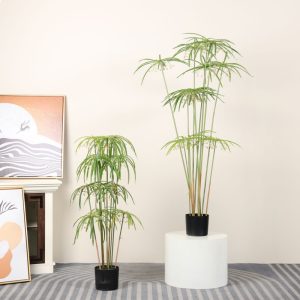On a Saturday morning in July, the sunlight poured through the white curtains in Emily’s living room like carefully cut gold foil, casting delicate patches of light on the pale grey oak floor. As I stood in the entrance hall, changing my shoes, the first thing that caught my attention was not the cinnamon scent floating in the air (which I later learned was from the freshly baked apple pie), but the “waterfall” of greenery cascading down from the living room ceiling. Deep green, light green, with hints of yellowed edges, the ivy vines hung lazily like a group of playful green sprites, winding down from a natural wood hanging rack, some leaves gently resting on the back of the beige linen sofa, while others mischievously reached toward the succulent pots on the windowsill.
“Oh my gosh, Emily,” I paused mid-step, my attention completely captured by the green. “When did you start growing ivy? This is so lush! I didn’t see this the last time I was here.” As I walked into the living room, the Persian rug beneath my feet felt like sinking into a cloud. The room was a typical Scandinavian style: white plaster moldings traced the outline of the ceiling, a few abstract paintings in muted Morandi tones adorned the walls, and the furniture was a combination of light wood and white, simple but warm. The hanging greenery was like the liveliest stroke in this otherwise subtle painting.
Emily, carrying coffee from the kitchen, had her light brown curls loosely pinned up with a wooden hairpin and flour on her apron. “It’s not real,” she said, setting the coffee cup on the coffee table, steam still rising from the milk foam. “Come closer, can you tell it’s fake?”
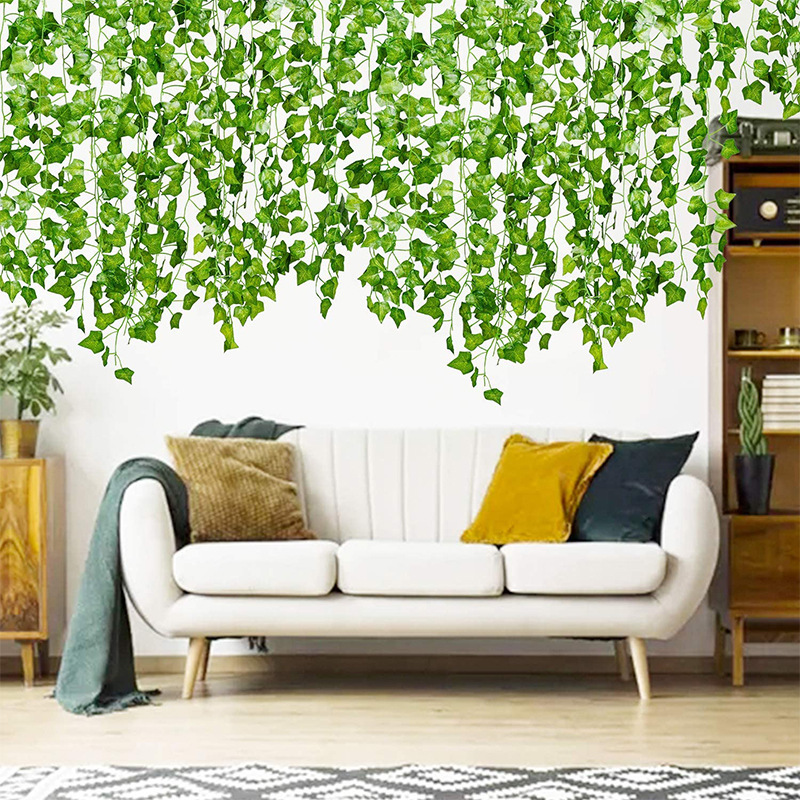
I walked under the vine cluster, and sunlight happened to slip through the edge of a heart-shaped leaf, casting a faint shadow on its surface. I reached out to touch the leaf, and it had a matte, velvety texture, not like the thin, brittle texture of real leaves, but surprisingly “meaty.” The vein patterns on the leaves were so distinct, it looked like they had been drawn with a fine pen, and the natural curl at the edges was perfectly replicated. “I can’t believe it!” I exclaimed. “Look at this leaf, it even has a bit of a translucent feel to it, just like the real ivy in my grandmother’s garden when the sunlight hits!”
“I used to have a prejudice against ‘fake plants,'” Emily laughed as she sat down on the sofa, handing me a slice of freshly cut apple pie. “Remember? Last year, I had three pots of real ivy on the balcony, planning for them to climb up the railing. But what happened? In the summer, I was worried they’d dry up in the sun, so I had to water them every morning and evening; in winter, I was afraid they’d freeze, so I had to bring them inside. The worst part was all the falling leaves. My vacuum had to pick up a pile of dead leaves every week, and there were always leaf fragments stuck between the tiles on the balcony.”
She pointed to the hanging rack above the sofa. “Then I saw a similar artificial vine at a friend’s house. It was hanging in her kitchen window, and even with all the cooking grease, the leaves were still clean, and the color hadn’t faded at all. I asked her how hard it was to maintain, and she said, ‘Just dust it off every six months.’ I was sold right there.”
I followed her gaze to the hanging vine, placed in a terracotta-colored hanging pot, with deliberately worn-out cracks along the edge of the pot. The vines cascaded down, with the longest strand almost a meter and a half in length, gently swaying in the breeze. “This one fits your style perfectly,” I said. “The terracotta pot matches the color of your coffee table.”
“Exactly,” Emily said, proudly tilting her chin. “I specifically chose this set with the hanging pot to avoid the trouble of picking out a pot myself. Look at the chain, it’s a black metal link that perfectly matches the black floor lamp in the living room. I’m all about the details.” She got up and walked to the window, gently adjusting the vines. “And you know the best part? It doesn’t have any environmental preferences. I once hung it in the bathroom (don’t laugh, I just wanted to see if it would work). The bathroom is so humid, but the leaves didn’t mildew; then I hung it in the study on the bookshelf, and even with the dim light, the color didn’t dull. It stayed green and fresh.”
I suddenly thought about my own experience renting an apartment. Last year, I had ivy growing on the windowsill, but the window faced west, and the afternoon sun was so intense that within a month, all the leaves wilted, and I had to throw them away. “This is perfect for us ‘plant killers,'” I said. “No need to water, no need to fertilize, and no need to worry about sunlight. It’s like a dream for lazy people.”
“Not just for lazy people,” Emily added. “People like me who work nine to five and often work weekends—who has time to tend to real plants? The real ivy I had before, just watering it took up so much of my mornings. Sometimes I’d come back from a week-long business trip and see them all wilted, and I’d feel so guilty. But with this one, even if I’m away for half a month, it’s still as fresh as ever. It’s such a relief.”
The Secret in the Light
“Take a closer look at the color of the leaves,” Emily pointed to a nearby vine. “It’s not that rigid ‘plastic green,’ right?” I leaned in and, sure enough, the leaves on the same vine had subtle differences in color. The leaves closest to the hanging pot were a deep, ink-like green, almost like silk dipped in ink; the middle leaves were bright emerald green, full of vitality; and the ones hanging at the bottom had a faint yellowish edge, like they had been kissed by sunlight.
“This is to mimic the color variations of real ivy under different lighting,” Emily explained. “Look at the windowsill over there, where the sunlight is brightest. The leaves look shinier, while the ones behind the sofa in the shadow are darker, just like the real thing.” Following her explanation, I looked at the vines in different light zones. Sure enough, the leaves in the shadow looked like little hidden spirits under the trees, quiet and mysterious, while the ones in the sunlight shimmered like gold dust, each one glowing.
“Also, you felt the texture, right?” She urged me to squeeze a leaf. “It’s not that hard plastic. It’s somewhat flexible, and when you squeeze it, it slowly bounces back, just like the ‘resilience’ of a fresh leaf. My cat sometimes tries to paw at it, but it doesn’t rip, unlike real leaves.” I looked over at her orange cat, who was lying on the sofa, its tail swishing lazily through the hanging vines. The leaves gently swayed, but the cat didn’t realize it was “fake grass” and tried to paw at it, which made both of us laugh.
“By the way, have you noticed the ‘pose’ of the vines?” Emily reached up and twisted a vine that was hanging too low. “The vine branches are flexible, so I can adjust them to whatever shape I want. When I first hung it up, I thought some parts were too dense and some too sparse, so I took it apart and rewound the vines. Doesn’t it look more like it’s growing naturally now?” I took a closer look and saw that the way the vines were wound was irregular—some parts were tight, while others were loose, and there was even one vine “playfully” sticking out from the gap in the rack, reaching toward the bookshelf on the other side, just like wild ivy growing wherever it pleased.
“Ever since I hung it, the vibe of my home has completely changed,” Emily said, taking a sip of her coffee and smiling with crescent-shaped eyes. “You saw it when you came in.”







